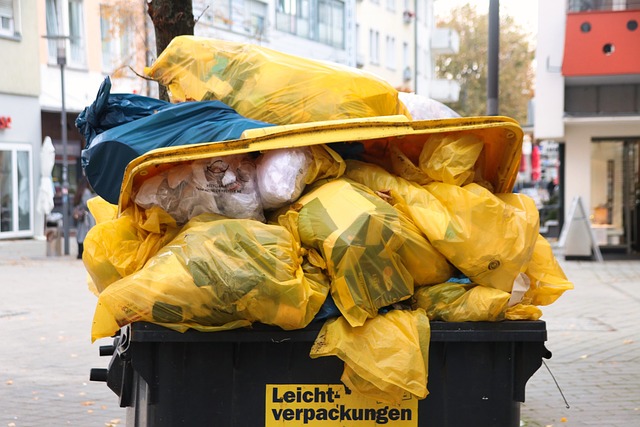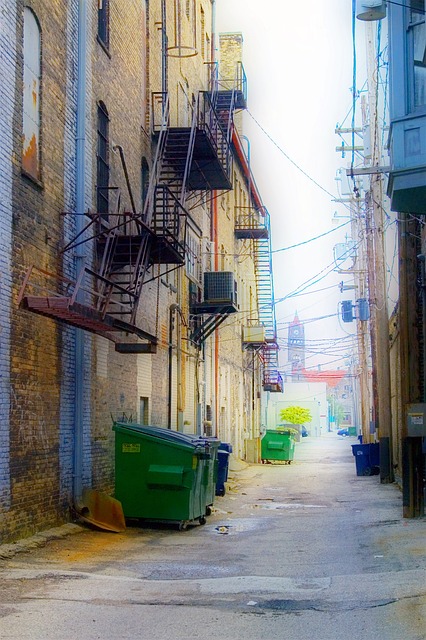The renovation of properties within the Queens Historic District necessitates strict adherence to local preservation guidelines to maintain the area's historical character. Contractors and property owners must use materials and construction methods that align with the Landmarks Preservation Commission's directives, ensuring architectural integrity is preserved. The integration of Queens Historic District Renovation Cleanup Dumpsters is crucial for managing renovation waste responsibly, with a focus on blending with the surroundings, complying with zoning ordinances, and adhering to environmental standards. These specialized dumpsters are positioned to minimize disruption, facilitating sustainable waste management practices such as on-site sorting and recycling, which contribute to the district's eco-conscious renovation efforts. The project exemplifies a balance between preserving the district's rich history and integrating modern living standards, setting a benchmark for similar initiatives nationwide. This approach ensures that the district's cultural heritage is respected while achieving a seamless blend of restoration and conservation.
navigating the intricate process of restoring historical structures, particularly within the Queens Historic District, demands meticulous expertise. This article delves into the essential role of cleanup dumpsters in sustaining preservation efforts, offering sustainable waste management strategies tailored for historic renovations. Through an overview of the district’s unique revitalization journey, documenting each phase, and engaging with local authorities to adhere to stringent permits and regulations, we explore how these practices uphold the integrity and charm of Queens’ historical legacy. Join us as we shed light on the nuances of preservation in action.
- Navigating the Nuances of Queens Historic District Renovation: An Overview
- The Role of Queens Historic District Renovation Cleanup Dumpsters in Preservation Efforts
- Expert Tips for Sustainable Waste Management During Historic Renovations in Queens
- Documenting the Restoration Process: Chronicles of Queens Historic District's Revitalization
- Engaging with Local Authorities: Permits and Regulations for Queens Historic District Renovation Projects
Navigating the Nuances of Queens Historic District Renovation: An Overview

When undertaking renovations within the Queens Historic District, it’s imperative to align with the local guidelines and regulations that preserve its historical integrity. These renovations necessitate a delicate approach, ensuring that any modifications enhance the district’s character while respecting its architectural legacy. Contractors and property owners must navigate the intricate requirements set forth by the Landmarks Preservation Commission, which includes careful consideration of materials, design elements, and construction methods that harmonize with the district’s historic fabric.
To facilitate these renovations effectively, securing reliable cleanup dumpsters is a critical component. These dumpsters serve as essential tools for managing the waste generated during the restoration process. They must be strategically placed to avoid disrupting the historical ambiance and comply with zoning laws specific to the district. The choice of a competent vendor, one familiar with the sensitivities of historic district renovations, guarantees that waste is disposed of responsibly and efficiently. This partnership between restoration expertise and waste management ensures that the district’s legacy remains intact while making way for modern functionality and safety.
The Role of Queens Historic District Renovation Cleanup Dumpsters in Preservation Efforts

The Queens Historic District in New York City is a testament to the region’s rich architectural and cultural heritage. Renovation projects within this district are not mere cosmetic updates but vital preservation efforts that ensure the longevity and authenticity of historic structures. A critical component of these renovations is the strategic deployment of Queens Historic District Renovation Cleanup Dumpsters. These dumpsters play an indispensable role in facilitating the orderly disposal of construction debris, which is a necessary part of any restoration work. They are strategically placed to minimize disruption to the surrounding area and historical ambiance, allowing for efficient waste management while maintaining the integrity of the neighborhood’s aesthetic and historical character. The use of these dumpsters adheres to strict environmental regulations, promoting sustainable practices within the district. Contractors and preservationists working in the Queens Historic District rely on these dumpsters to comply with local and federal guidelines regarding the handling and disposal of materials, ensuring that the renovation process upholds the values of conservation and respect for history. These efforts not only safeguard the physical fabric of the historic district but also protect the environment by preventing waste from ending up in landfills indiscriminately.
Expert Tips for Sustainable Waste Management During Historic Renovations in Queens

When undertaking renovations in the Queens Historic District, sustainable waste management becomes a paramount concern. The unique character of these structures demands a meticulous approach to ensure both the preservation of historical integrity and environmental stewardship. Expert tips for effective waste management during such projects include selecting the right-sized cleanup dumpsters from reputable providers like ZTERS, which specialize in waste solutions for historic renovations. These containers should be strategically placed to minimize disruption to the surrounding area, a common concern in historic districts where aesthetics and preservation are top priorities.
Furthermore, it is crucial to sort and recycle materials on-site whenever possible. This not only reduces the amount of waste sent to landfills but also can facilitate easier disposal for items like asbestos or lead paint, which must be handled according to specific regulations due to their potential hazards. Engaging with local Queens environmental agencies can provide guidance on recycling programs and disposal protocols tailored to historic renovation projects. By adhering to these sustainable practices, renovations in the Queens Historic District can set a standard for responsible construction while preserving the charm and history that define this unique area.
Documenting the Restoration Process: Chronicles of Queens Historic District's Revitalization

The Queens Historic District, steeped in rich history and architectural significance, underwent a comprehensive revitalization process that serves as a prime example of restoration expertise. This transformation was meticulously documented, ensuring a detailed account of every stage of the renovation. A key component of this process involved the careful cleanup and disposal of materials through the strategic placement of dumpsters at various sites within the district. These dumpsters were not mere receptacles but integral to maintaining a clean and safe work environment, facilitating the efficient removal of debris and waste as the restoration progressed. The documentation captured the meticulous sorting and recycling efforts, highlighting the commitment to sustainability amidst revival efforts. This detailed chronicle provides valuable insights into the complexities of preserving historical integrity while incorporating modern standards of living. It is a testament to the skillful balance between honoring the past and creating a livable, vibrant community for the future. The Queens Historic District’s renovation project stands as a model for similar endeavors across the nation, showcasing the effectiveness of careful planning and professional execution in restoration projects.
Engaging with Local Authorities: Permits and Regulations for Queens Historic District Renovation Projects

When undertaking renovation projects within Queens Historic District, engagement with local authorities is paramount to ensure compliance with permits and regulations that protect the area’s historical integrity. Projects of this nature require a keen understanding of the district’s specific rules, which are designed to preserve its architectural significance and cultural heritage. Homeowners and contractors must navigate the intricate guidelines set forth by the Landmarks Preservation Commission (LPC), which govern renovation work to maintain the historic character of the buildings. A critical step in this process is obtaining the necessary permits, which dictate the types of materials used, the methods of construction or demolition, and the overall impact on the district’s aesthetic landscape. Additionally, coordinating with local waste management services for efficient cleanup dumpsters placement and removal is essential to maintain the district’s ambiance and adhere to environmental regulations. This not only facilitates a smooth renovation process but also ensures that the historical value of Queens Historic District remains intact for future generations to appreciate.
In concluding our exploration of the intricate process of restoring the Queens Historic District, it is evident that the undertaking requires a harmonious blend of expertise and commitment to preservation. The pivotal role of Queens Historic District Renovation Cleanup Dumpsters in facilitating sustainable waste management cannot be overstated, as they ensure the integrity of historical sites while accommodating modern needs. Homeowners, contractors, and historians alike must collaborate, guided by local regulations and leveraging best practices for documenting and executing renovations. Through these concerted efforts, the Queens Historic District continues to stand as a beacon of history, now fortified with contemporary sustainability practices. The collective work underscores the importance of preserving our past while embracing the future, ensuring that the district remains a vibrant part of Queens for generations to come.
